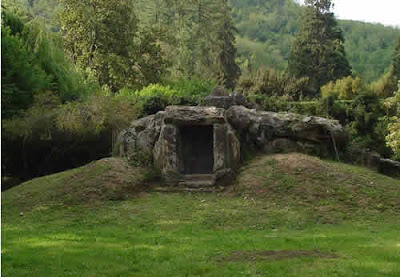Umbria (Italian pronunciation: [ˈumbrja]) is a region of modern central Italy. It is one of the smallest Italian regions and the only peninsular region that is landlocked.
Its capital is Perugia.
Assisi and Norcia are historical towns associated with St. Francis of Assisi, and St. Benedict.
The official language, as in the rest of Italy, is Italian.
History
The region is named for the Umbri tribe, one of those who were absorbed by the expansion of the Romans. Pliny the Elder recounts a fanciful derivation for the tribal name from the Greek ὄμβρος "a shower", which had led to the confused idea that they had survived the Deluge familiar from Greek mythology, giving them the claim to be the most ancient race in Italy.[3] In fact they belonged to a broader family of neighbouring tribes with similar roots. Their language was Umbrian, one of the Italic languages, related to Latin and Oscan.
The Umbri probably sprang, like neighbouring tribes, from the creators of the Terramara, and Villanovan culture in northern and central Italy, who entered north-eastern Italy at the beginning of the Bronze Age.
The Etruscans were the chief enemies of the Umbri, and the Etruscan invasion went from the western seaboard towards the north and east (lasting from about 700 to 500 BC), eventually driving the Umbrians towards the Apenninic uplands and capturing 300 Umbrian towns. Nevertheless, the Umbrian population does not seem to have been eradicated in the conquered districts.
After the downfall of the Etruscans, Umbrians attempted to aid the Samnites in their struggle against Rome (308 BC); but communications with Samnium were impeded by the Roman fortress of Narni (founded 298 BC). At the great battle of Sentinum (295 BC), which was fought in their own territory, the Umbrians did not substantially help the Samnites.
A typical landscape of the Umbrian countryside.
The Roman victory at Sentinum started a period of integration under the Roman rulers, who established some colonies (e.g., Spoletium) and built the via Flaminia (220 BC), which became a principal vector for Roman development in Umbria. During Hannibal's invasion in the second Punic war, the battle of Lake Trasimene was fought in Umbria, but the Umbrians did not aid him.
View of Assisi.
During the Roman civil war between Mark Antony and Octavian (40 BC), the city of Perugia supported Antony and was almost completely destroyed by the latter.
In Pliny's time, 49 independent communities still existed in Umbria, and the abundance of inscriptions and the high proportion of recruits in the imperial army attest to its population.
View of Norcia.
The modern region of Umbria, however, is essentially different from the Umbria of Roman times (see Roman Umbria), which extended through most of what is now the northern Marche, to Ravenna, but excluded the west bank of the Tiber. Thus Perugia was in Etruria, and the area around Norcia was in the Sabine territory.
The Cathedral of Orvieto
After the collapse of the Roman empire, Ostrogoths and Byzantines struggled for the supremacy in the region; the Lombards founded the duchy of Spoleto, covering much of today's Umbria. When Charlemagne conquered most of the Lombard kingdoms, some Umbrian territories were given to the Pope, who established temporal power over them. Some cities acquired a form of autonomy (the comuni); they were often at war with each other in the context of the more general conflict between the papacy and the Holy Roman Empire or between the Guelphs and the Ghibellines.
In the 14th century, the signorie arose, but were subsumed into the Papal States, which ruled the region until the end of the 18th century.
After the French Revolution and the French conquest of Italy, Umbria was part of the ephemeral Roman Republic (1798–1799) and of the Napoleonic Empire (1809–1814).
After Napoleon's defeat, the Pope regained Umbria until 1860.
After the Risorgimento, the expansion of the Piedmontese, and Italian unification, in 1861 Umbria was incorporated in the Kingdom of Italy.
The borders of Umbria were fixed in 1927, with the creation of the province of Terni and the separation of the province of Rieti, which was incorporated in Lazio.
In 1946 Umbria became part of the Italian Republic
 21:46
21:46
 homesweethome
homesweethome














 Posted in:
Posted in: 








0 意見:
Post a Comment